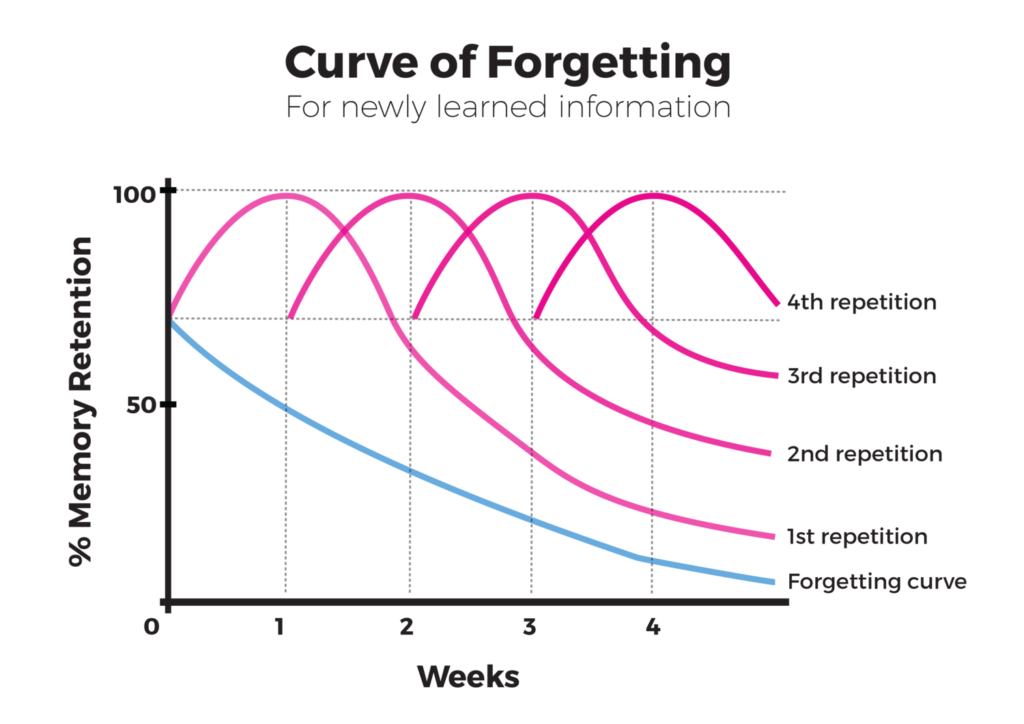As students, we have many responsibilities from school, work, and extracurricular activities. I felt so many times that there were not enough hours in a week for all I needed to do. The pressure to perform well in all aspects of life is real. For a long time, putting the most hours into each aspect of my life was necessary to attain my objectives.
That was until I started reading and watching videos on studying techniques, and learning about active recall methods. This technique helps study more efficiently, making it possible to take less time to study for a class. It’s all about being more engaged and less passive while studying. Studying a little bit every day makes it worth it in the end.
The active recall method is rooted in cognitive psychology and memory research. It’s a method promoted by psychologists and researchers as a practical learning technique. It is based on the work of a German psychologist, Hermann Ebbinghaus, who studied memory. His research laid the groundwork for understanding the spacing effect and the forgetting curve, which are relevant to the effectiveness of active recall. Robert Bjork, a contemporary cognitive psychologist, has studied the active recall method and its effect on strengthening memory and improving long-term retention.
How Can You Use Active Recall in Your Study Session?
Contents
Definition – What is it?
Benefits and Inconvenience
Methods – How to implement it?
Definition - What is it?
The active recall studying method is based on the capacity of your brain to retrieve information by training it. When you try to recall past information, your brain is active and engaged, unlike when simply re-reading and reviewing. To do this method, you need to recall information without looking at the source material and training repetitively over a period of time. It will stimulate your memory.
For example, you remember ordinary things without effort because you have trained your brain to retrieve those pieces of information so many times that they are engraved in your memory. Think about the alphabet. Yes, we learned it when we were six, but we remember them because we still use them daily.
Look at the following graph. It shows that the more we retrieve new information over a long period of time, the better we retain it.

Benefits and Inconvenience
This method helps reduce the time spent studying, even if it may seem counterintuitive. You won’t need to rush during exam week by spreading your study session over many months. You can choose when you are studying and how long. It is a compelling study method, which is not valid for passive learning.
It might also increase your grades. By consistently testing yourself on the material, you’re reinforcing connections in your brain and making the information more readily accessible. You can remember information for a more extended period of time and enhance your understanding of the material. You are training your brain to retrieve information actively.
As you will see later on, there are many different ways for you to put this method into practice.
One inconvenience to this method is the adaptation time since we are not used to studying this way. The process may feel uncomfortable initially and require you to keep an open mind. However, you will see overall improvements after a while. And it is worth it!
Methods - How to implement it?
Start by finding a quiet place to study and set up your schedule. I always start a session identifying my study goals, such as finishing understanding a topic or revising certain classes. Giving yourself a schedule and objectives will help you motivate yourself to study.
Understanding your material is vital before using the active recall method. The technique will only help you remember the information but not make you understand it. Teachers often want to know if you can understand a subject well enough. It’s probably not very useful to remember something without understanding it. Also, it can be hard to remember a topic you don’t understand the meaning.
You can then start to break down the content into manageable chunks. Putting the information into a logical compartment will make it easier to recall. For example, if you are studying World War 2, you can devise the topic into the causes, the consequences, and the events.
Different ways to do active recall:
Flashcards – Creating flashcards with questions on one side and answers on the other is a classic active recall method. You test yourself by attempting to answer the question before flipping the card to check your accuracy.
Self-Quizzing – Instead of re-reading notes or textbooks, cover the material and try to recall key points or concepts. Write down or verbally articulate what you remember, then check for accuracy.
Summarization – After studying a section, summarize the main points or concepts without looking at your notes. This forces you to recall and organize information in your own words.
Teaching or Explaining to Others – Teaching someone else what you’ve learned effectively reinforces your understanding. It requires you to retrieve and explain information, consolidating your knowledge.
Practice Tests – Taking practice tests or past exam papers under timed conditions simulates the test environment. It challenges your memory retrieval and helps identify areas that need further review.
Spaced Repetition – Reviewing material at spaced intervals—increasing the time between each review based on how well you remember—helps strengthen long-term retention.
Concept Mapping – Create visual representations of interconnected ideas or concepts. Drawing diagrams or mind maps from memory helps reinforce relationships between different pieces of information.
Active Reading – Pause periodically and summarize what you’ve read, predict what might come next, or ask yourself questions about the material to ensure active engagement.
Recitation – Reading information aloud or reciting critical points from memory helps reinforce memory retention through auditory stimulation.
Study every day or every other day. Regular, short sessions work better than long, infrequent ones. You can study 30 minutes to 1 hour every day after returning from school. Taking breaks during your study routine is excellent for your focus and retention. It also makes study sessions more enjoyable!
I recommend mixing different active recall methods during your study. It will make it more fun, and your memory should see a problem from different angles. Start with self-quizzing, move to flashcards, summarize a section, and then attempt teaching or explaining the concepts to yourself or others.
When you feel comfortable with one subject, study other topics and return to it a few days later. The trick is never to assume that you remember entirely a topic after studying it once. Wait a few days or even weeks to go back to it. You will realize that you would have forgotten some parts of it. Reviewing the subject will train your brain to retrieve the lost information, which will help you remember it better next time. After a few tries, you can remember everything even if you have yet to revise the subject on the same day.
Sticking to your schedule and making active recall a habitual part of your study routine is essential. Consistency is crucial in reaping the benefits of this technique.
To stay motivated, you should keep track of your progress. Keep track of what you’ve mastered and which areas need more focus. You will also be able to adjust your study routine accordingly. By reflecting on your past study sessions and your progress, you will better understand your learning style, subject matter, and your comfort with different active recall techniques.
Using the active recall method can improve your study sessions and overall school experience. You can put less time into studying and more into what you want. I started using this technique to improve my grades when I started university and felt more confident before every exam. If you think your problem is about motivating yourself to study, I recommend that you look at my article on the Pomodoro technique : Mastering Efficiency: How to Use the Pomodoro Technique for Studying?
